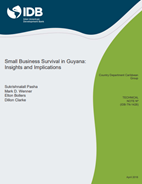Small Business Survival in Guyana: Insights and Implications
Date
Apr 2018
Most businesses in Guyana are small and medium-scale enterprises (SMEs). SMEs are assumed to generate a significant share of employment and contribute to wealth creation. However, they operate in a less than auspicious business climate, and their failure rate is high. One of the perennial complaints of small business operators is lack of access to credit. Two of the reasons that financial intermediaries are reluctant to grant credit to SMEs are the perceived higher risk of failure and lack of adequate collateral. This study sought to identify the factors responsible for SMEs’ survival in Guyana using data collected from a country-wide survey which captured the profile of 380 SMEs and their founders. The Kaplan-Meier (KM) estimator and Cox Proportional Hazard Model (CPHM) were employed to calculate survivability of the SMEs based on firm characteristics and founder's profile. Gender, location, and economic activity consistently explained the survival of these businesses. However, factors such as the age, experience, and educational background of the owner, as well as, the source of start-up funding, access to government procurement, legal form, and business strategy were found not to be significant determinants of SMEs’ survivability. Further, the significance of size as an essential determinant was inconclusive. Based on the estimates derived from our survival function, a prototypical credit risk calculator was developed to illustrate how a model can be constructed with non-financial data to quantify the risk of firm failure. The model could be further refined and used by practitioners to better screen prospective SME loan applicants and reduce some of the imperfect information barriers.




